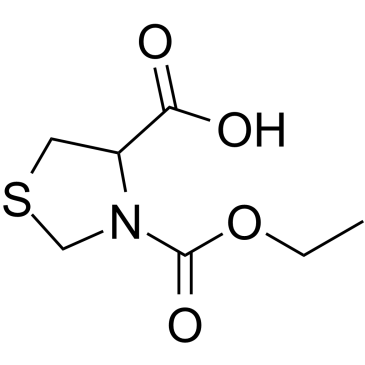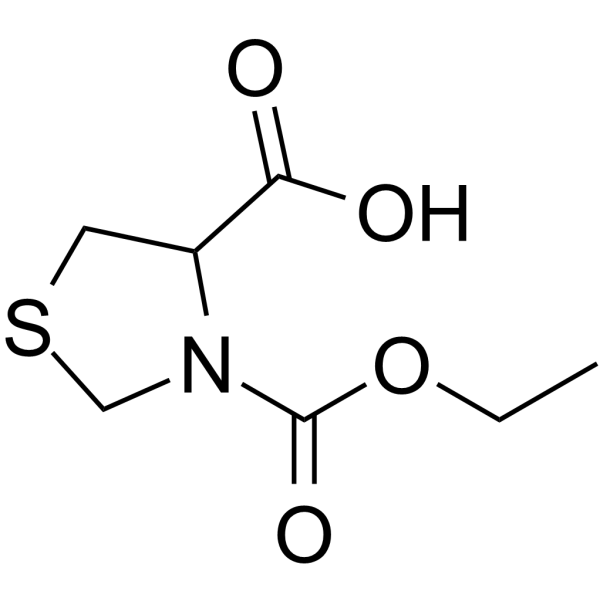(Rac)-Telmesteine,98.0%
产品编号:Bellancom-108285| CAS NO:127657-29-8| 分子式:C7H11NO4S| 分子量:205.23
(Rac)-Telmesteine 是一种蛋白酶抑制剂,因此适宜作为酶稳定剂,来自专利专利 WO 2017220302 A1化合物 II-1。(Rac)-Telmesteine 可用作含蛋白酶的洗涤剂和清洗剂中的酶稳定剂。
本网站销售的所有产品仅用于工业应用或者科学研究等非医疗目的,不可用于人类或动物的临床诊断或者治疗,非药用,非食用,
(Rac)-Telmesteine
| 产品介绍 | (Rac)-Telmesteine 是一种蛋白酶抑制剂,因此适宜作为酶稳定剂,来自专利 WO 2017220302 A1化合物 II-1。(Rac)-Telmesteine 可用作含蛋白酶的洗涤剂和清洗剂中的酶稳定剂。 | ||||||||||||||||
|---|---|---|---|---|---|---|---|---|---|---|---|---|---|---|---|---|---|
| 生物活性 | (Rac)-Telmesteine is a protease inhibitor and is thus a suitable enzyme stabilizer extracted from patent WO 2017220302 A1, compound II-1. (Rac)-Telmesteine can be used as an enzyme stabilizer in protease-containing detergents and cleaning agents. | ||||||||||||||||
| 体外研究 | |||||||||||||||||
| 体内研究 | |||||||||||||||||
| 体内研究 | |||||||||||||||||
| 性状 | Solid | ||||||||||||||||
| 溶解性数据 |
In Vitro:
DMSO : ≥ 250 mg/mL (1218.15 mM) * "≥" means soluble, but saturation unknown. 配制储备液
*
请根据产品在不同溶剂中的溶解度选择合适的溶剂配制储备液;一旦配成溶液,请分装保存,避免反复冻融造成的产品失效。 In Vivo:
请根据您的实验动物和给药方式选择适当的溶解方案。以下溶解方案都请先按照 In Vitro 方式配制澄清的储备液,再依次添加助溶剂:
——为保证实验结果的可靠性,澄清的储备液可以根据储存条件,适当保存;体内实验的工作液,建议您现用现配,当天使用;
以下溶剂前显示的百
| ||||||||||||||||
| 运输条件 | Room temperature in continental US; may vary elsewhere. | ||||||||||||||||
| 储存方式 |
| ||||||||||||||||
| 参考文献 |
|
3-Ethyl (-)-Thiazolidine-3,4-dicarboxylate
Revision number: 5
SAFETY DATA SHEET Section1. IDENTIFICATION Product name:3-Ethyl (-)-Thiazolidine-3,4-dicarboxylate Revision number:5 Section2. HAZARDS IDENTIFICATION GHS classification PHYSICAL HAZARDSNot classified Not classified HEALTH HAZARDS ENVIRONMENTAL HAZARDSNot classified GHS label elements, including precautionary statements Pictograms or hazard symbolsNone No signal word Signal word Hazard statementsNone None Precautionary statements: Section3. COMPOSITION/INFORMATION ON INGREDIENTS Substance/mixture:Substance Components:3-Ethyl (-)-Thiazolidine-3,4-dicarboxylate Percent:>98.0%(T) CAS Number:127657-29-8 Synonyms:(-)-3-Carbethoxythiazolidine-4-carboxylic Acid , (-)-3-Ethoxycarbonylthiazolidine-4- carboxylic Acid , (-)-Thiazolidine-3,4-dicarboxylic Acid 3-Ethyl Ester C7H11NO4S Chemical Formula: Section4. FIRST AID MEASURES Inhalation:Remove victim to fresh air and keep at rest in a position comfortable for breathing. Get medical advice/attention if you feel unwell. Skin contact:Remove/Take off immediately all contaminated clothing. Rinse skin with water/shower. If skin irritation or rash occurs: Get medical advice/attention. Eye contact:Rinse cautiously with water for several minutes. Remove contact lenses, if present and easy to do. Continue rinsing. If eye irritation persists: Get medical advice/attention. Ingestion:Get medical advice/attention if you feel unwell. Rinse mouth. A rescuer should wear personal protective equipment, such as rubber gloves and air- Protection of first-aiders: tight goggles. Section5. FIRE-FIGHTING MEASURES Suitable extinguishingDry chemical, foam, water spray, carbon dioxide. media: Specific hazards arising Take care as it may decompose upon combustion or in high temperatures to from the chemical:generate poisonous fume. 3-Ethyl (-)-Thiazolidine-3,4-dicarboxylate Section5. FIRE-FIGHTING MEASURES Precautions for firefighters: Fire-extinguishing work is done from the windward and the suitable fire-extinguishing method according to the surrounding situation is used. Uninvolved persons should evacuate to a safe place. In case of fire in the surroundings: Remove movable containers if safe to do so. Special protectiveWhen extinguishing fire, be sure to wear personal protective equipment. equipment for firefighters: Section6. ACCIDENTAL RELEASE MEASURES Use personal protective equipment. Keep people away from and upwind of spill/leak. Personal precautions, protective equipment and Entry to non-involved personnel should be controlled around the leakage area by emergency procedures: roping off, etc. Environmental precautions: Prevent product from entering drains. Methods and materials for Sweep dust to collect it into an airtight container, taking care not to disperse it. containment and cleaning Adhered or collected material should be promptly disposed of, in accordance with up: appropriate laws and regulations. Section7. HANDLING AND STORAGE Precautions for safe handling Handling is performed in a well ventilated place. Wear suitable protective equipment. Technical measures: Prevent dispersion of dust. Wash hands and face thoroughly after handling. Use a local exhaust if dust or aerosol will be generated. Advice on safe handling: Avoid contact with skin, eyes and clothing. Conditions for safe storage, including any incompatibilities Storage conditions:Keep container tightly closed. Store in a cool and dark place. Store away from incompatible materials such as oxidizing agents. Packaging material:Comply with laws. Section8. EXPOSURE CONTROLS / PERSONAL PROTECTION Install a closed system or local exhaust as possible so that workers should not be Engineering controls: exposed directly. Also install safety shower and eye bath. Personal protective equipment Respiratory protection: Dust respirator. Follow local and national regulations. Hand protection:Protective gloves. Eye protection:Safety glasses. A face-shield, if the situation requires. Skin and body protection: Protective clothing. Protective boots, if the situation requires. Section9. PHYSICAL AND CHEMICAL PROPERTIES Physical state (20°C):Solid Form:Crystal- Powder Colour:White - Very pale yellow Odour:No data available pH: No data available Melting point/freezing point:98°C No data available Boiling point/range: Flash point:No data available Flammability or explosive limits: No data available Lower: Upper:No data available No data available Relative density: Solubility(ies): No data available [Water] [Other solvents]No data available 3-Ethyl (-)-Thiazolidine-3,4-dicarboxylate Section10. STABILITY AND REACTIVITY Chemical stability:Stable under proper conditions. Possibility of hazardous No special reactivity has been reported. reactions: Incompatible materials: Oxidizing agents Hazardous decomposition Carbon monoxide, Carbon dioxide, Nitrogen oxides (NOx), Sulfur oxides products: Section11. TOXICOLOGICAL INFORMATION No data available Acute Toxicity: Skin corrosion/irritation: No data available No data available Serious eye damage/irritation: Germ cell mutagenicity: No data available Carcinogenicity: IARC =No data available NTP =No data available No data available Reproductive toxicity: Section12. ECOLOGICAL INFORMATION Ecotoxicity: No data available Fish: Crustacea:No data available Algae:No data available Persistence / degradability: No data available BioaccumulativeNo data available potential(BCF): Mobility in soil Log Pow:No data available No data available Soil adsorption (Koc): Henry's LawNo data available constant(PaM3/mol): Section13. DISPOSAL CONSIDERATIONS Recycle to process, if possible. Consult your local regional authorities. You may be able to dissolve or mix material with a combustible solvent and burn in a chemical incinerator equipped with an afterburner and scrubber system. Observe all federal, state and local regulations when disposing of the substance. Section14. TRANSPORT INFORMATION Hazards Class:Does not correspond to the classification standard of the United Nations Not listed UN-No: Section15. REGULATORY INFORMATION Safe management ordinance of dangerous chemical product (State Council announces on January 26, 2002 and revised on February 16,2011): Safe use and production, the storage of a dangerous chemical, transport, loading and unloading were prescribed. 3-Ethyl (-)-Thiazolidine-3,4-dicarboxylate SECTION 16 - ADDITIONAL INFORMATION N/A |
 有竞争力的价格
有竞争力的价格匹配竞争对手的价格
 极速物流
极速物流效率为先
 技术支持
技术支持专业经验 贴心服务
 现货库存
现货库存50000+库存





 浙公网安备 33010802013016号
浙公网安备 33010802013016号